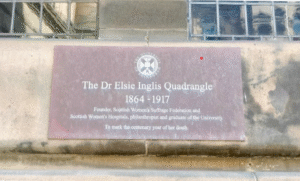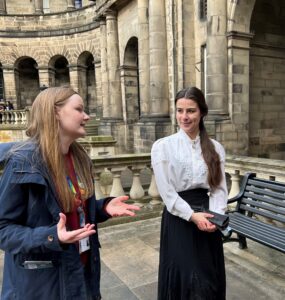Old Medical School
Elsie Inglis was a Scottish doctor, surgeon and suffragist who qualified at the University of Edinburgh. She started her studies at a college opened by physician Sophia Jex-Blake, before opening her own competing school due to disapproval of Jex-Blake’s teaching methods. During her time in Edinburgh, Elsie lived with fellow doctor and suffragette Flora Murray, and it is suspected theirs was a romantic relationship.

During WWI, Inglis was rejected by the British War Office and told to “go home and sit still” when she offered them ready-made medical units staffed by trained women. Undeterred, she raised the equivalent of £53 million in today’s money to send 14 medical teams across Europe. She travelled to Serbia with one of her teams where she was captured and held prisoner. She was the first woman to be awarded the Serbian Order of the White Eagle. Inglis only left war-torn Europe and returned to the UK when her health forced her to. She died in 1917, one day after arriving in Britain, from cancer.
Mary Pickford was a neuroendocrinologist, researching the interaction between the nervous system and the endocrine system. She became the first woman appointed to a professorship in medicine at Edinburgh, when she was made Professor of Physiology in 1966. Pickford was also the first woman to be elected to the Pharmacological Society in 1928, and she later remarked that wearing tweeds was essential if a female physiologist wanted to be taken seriously. Pickford made major contributions to our understanding of the central regulation of hormone release from the pituitary gland. Her research was outlined in her popular and hugely impactful book, “The Central Role of Hormones”.
Clara Marguerite Christian is widely recognised as the first Black female student to enrol at the University of Edinburgh, having “obstinately insisted on taking a full medical course”. She was born in Dominica in 1895 and began her degree in medicine in 1915.
Whilst studying at Edinburgh, Christian met her future husband, Edgar Gordon, and fell pregnant – at which point she dropped out of university. The couple married in 1917, and Gordon graduated and went on to a successful medical career. The impact of parenthood and lack of institutional support was felt solely by Christian, who never graduated.
Gordon and Christian divorced in 1927, and Christian successfully applied for a position at Achimota College, in modern-day Ghana. However, she was a single parent, and the role’s insecurity and relocation requirement meant she had to turn it down. Although a variety of systemic factors inhibited Christian’s own career, her determination to study medicine at Edinburgh paved the way for future women of colour at the University.
Old College
Eleanor Ormerod was a British entomologist who established the fields of economic and agricultural entomology. She published extensively on controlling insect pests from 1877-1900, establishing her as an authority on the topic.
Ormerod was born in 1828 to a wealthy English family, however she was denied the educational opportunities her brothers received and never studied at university. Ormerod had developed an understanding of insects on her family’s estate at a young age, but she did not begin researching entomology in earnest until she was in her 40s, after her parents had passed away.

Due to Ormerod’s extensive publications, she became known as one of the greatest authorities on economic entomology in the world. She was the first woman to be given an honorary degree from Edinburgh University, and was also the first woman to be honoured with a Fellowship in the Meteorological Society. Her portrait used to hang at the foot of the south-east stair in Old College, however it has since been taken down due to an ongoing project.
Surgeon’s Hall
The Edinburgh Seven were a group of women, led by Sophia Jex-Blake, who made history by becoming the first female students to be officially matriculated at a British university. They began studying medicine at the University of Edinburgh in 1869 although they were later denied the opportunity to graduate due to gender bias.
In November 1870, the Edinburgh Seven faced violent opposition when they tried to take an anatomy exam at Surgeon’s Hall. A large crowd of several hundred rioters, including male students, blocked the street, shouting abuse and pelting the Seven with rubbish and mud. The building gates were also slammed in their faces, preventing the women from entering the exam hall.
This attack, known as the Surgeons’ Hall riot, attracted widespread publicity and showed the extreme hostility the women experienced. Because of the riot and pressure from male students, the University of Edinburgh later stopped the women from attending classes. As a result, the Edinburgh Seven had to finish their studies abroad or at a separate medical school created by Jex-Blake.
Jex-Blake founded the Edinburgh School of Medicine for Women in 1886. Upon her retirement in 1899, Jex-Blake moved to Sussex with Dr Margaret Todd – her romantic partner and one of the first students at her medical school. The two spent the rest of their lives together. Todd, a physician and writer, is also remembered for coining the term “isotope” in scientific literature.
Chrystal Macmillan Building
Chrystal Macmillan was a suffragist, peace activist, barrister, and the first female science graduate from the University of Edinburgh, as well as the institution’s first female honours graduate in mathematics.
Macmillan was born in Edinburgh in 1872, and in 1892 became among the first female students to enrol at the University. She studied science subjects, and graduated with a first-class honours in mathematics and natural philosophy in 1896. Macmillan also returned to the University after graduation to undertake a further degree in Moral Philosophy and Logic.
Macmillan was an active member of the Edinburgh National Society for Women’s Suffrage, and protested the disconnect between female students being allowed membership of the General Council of Edinburgh University, and yet not allowed to vote for the Member of Parliament who would represent the university seat.
When WWI broke out, Macmillan became a peace activist, forming the International Congress of Women. Many of the peace proposals of this congress were used during the formation of the League of Nations, the predecessor to the United Nations. As part of her activism, Macmillan also condemned the harsher terms of the Treaty of Versailles at the end of WWI, adamant they would cause future conflict. She passed away in 1937, just two years before she was proven right.
This was an excerpt from Katherine Scott and Katie Grieve’s book, “Edinburgh Historic Walks: A Summary of Hidden Histories”.


